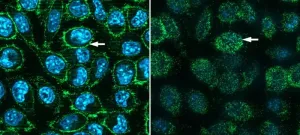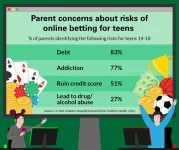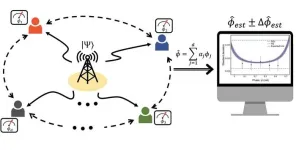(Press-News.org) A team of researchers from the School of Energy and Chemical Engineering at UNIST, jointly led by Professors Sung-Yeon Jang, Jungki Ryu, and Ji-Wook Jang, in collaboration with Professor Sang Kyu Kwak from Korea University, have achieved remarkable advancements in the stability and efficiency of perovskite solar cells. Their groundbreaking work not only paves the way for the commercialization of perovskite solar cells (PSCs), but also offers significant potential in green hydrogen production technology, ensuring long-term operation with high efficiency.
Perovskite solar cells (PSCs) have garnered attention due to their reduced toxicity and broad light absorption capabilities, making them highly promising for photovoltaic applications. However, the presence of inherent ionic vacancies in tin-lead halide perovskites (TLHPs) has posed challenges, leading to accelerated device degradation through inward metal diffusion.
To address this challenge, the research team developed a chemically protective cathode interlayer using amine-functionalized perylene diimide (PDINN). By leveraging its nucleophilic sites to form tridentate metal complexes, PDINN effectively extracts electrons and suppresses inward metal diffusion. The novel solution-processed PDINN cathode interlayer has showcased remarkable performance in stabilizing TLHP-based photovoltaic (PV) and photoelectrochemical (PEC) devices.
The PV device achieved an impressive efficiency of 23.21%, with over 81% retention after 750 hours of operation at 60 °C, and more than 90% retention after 3100 hours at 23 ± 4 °C. Additionally, the TLHP-based PEC devices, coupled with biomass oxidation, exhibited a record-high bias-free solar hydrogen production rate of 33.0 mA cm−2, approximately 1.7-fold higher than the target set by the U.S. Department of Energy for one-sun hydrogen production.
Their innovative design of the cathode interlayer has successfully demonstrated the immense potential of TLHPs for efficient and stable photoconversion.
“We have dramatically increased the long-term stability of tin-lead PSCs,” explained Professor Jang. “Our goal is not only to convert light energy into electrical energy but also to develop eco-friendly methods for producing basic chemicals, such as hydrogen, which form the foundation of various industries.”
The research findings have been published online in Advanced Energy Materials on November 30, 2023. The study received support from the National Research Foundation of Korea (NRF) under the Ministry of Science and ICT (MSIT).
Journal Reference
Muhibullah Al Mubarok, Yuri Choi, Rashmi Mehrotra, et al., “Efficient and Stable Tin–Lead Perovskite Photoconversion Devices Using Dual-Functional Cathode Interlayer,” Adv. Energy Mater., (2023).
END
Breakthrough research enhances stability and efficiency of perovskite solar cells
2024-01-22
ELSE PRESS RELEASES FROM THIS DATE:
Scientists trap krypton atoms to form one-dimensional gas
2024-01-22
For the first time, scientists have successfully trapped atoms of krypton (Kr), a noble gas, inside a carbon nanotube to form a one-dimensional gas.
Scientists from the University of Nottingham’s School of Chemistry used advanced transmission electron microscopy (TEM) methods to capture the moment when Kr atoms joined together, one by one, inside a “nano test tube” container with diameter half a million times smaller than the width of a human hair. The research has been published in the journal of the American Chemical Society.
The behaviour of atoms has been studied by scientists ever since it was hypothesized that ...
Hybrid machine learning method boosts resolution of electrical impedance tomography for structural imaging
2024-01-22
Electrical impedance tomography (EIT) is a non-destructive imaging technique used to visualize the interior of materials. In this method, an electric current is injected between two electrodes, creating an electric field, and other electrodes measure distortions caused by the presence of foreign objects inside the material. Compared to other imaging methods, such as X-ray imaging, computed tomography, and magnetic resonance imaging, EIT has the advantages of being low cost and less cumbersome as it does not require large magnets or radiation. Therefore, it holds great potential as a non-destructive structural health monitoring ...
New study finds liquid laundry detergent packet exposure burden among young children remains; increase in exposures among older children, teens, and adults
2024-01-22
(COLUMBUS, Ohio) – A new study conducted by researchers at the Center for Injury Research and Policy of the Abigail Wexner Research Institute at Nationwide Children’s Hospital and the Central Ohio Poison Center investigated trends in calls to poison centers across the country for exposures to liquid laundry detergent packets. The study investigators identified declines in the number, rate and severity of liquid laundry detergent packet exposures among children younger than 6 years. However, the exposure burden remained high. Additionally, exposures have increased among older children, teens and adults.
The study, published in Clinical Toxicology, found that in the most recent ...
Food from urban agriculture has carbon footprint 6 times larger than conventional produce, study shows
2024-01-22
Photos
A new University of Michigan-led international study finds that fruits and vegetables grown in urban farms and gardens have a carbon footprint that is, on average, six times greater than conventionally grown produce.
However, a few city-grown crops equaled or outperformed conventional agriculture under certain conditions. Tomatoes grown in the soil of open-air urban plots had a lower carbon intensity than tomatoes grown in conventional greenhouses, while the emissions difference between conventional and urban agriculture vanished for air-freighted crops like asparagus.
"The exceptions revealed by our ...
Scientists make COVID receptor protein in mouse cells
2024-01-22
UPTON, NY—A team of scientists at the U.S. Department of Energy’s (DOE) Brookhaven National Laboratory and Columbia University has demonstrated a way to produce large quantities of the receptor that SARS-CoV-2, the virus that causes COVID-19, binds to on the surface of human cells. That binding between the now-infamous viral spike protein and the human “ACE2” receptor is the first step of infection by the virus. Making functional human ACE2 protein in mouse cells gives scientists a new way to study these receptors and potentially put them to use. In addition, as described in a paper just published in the journal Virology, the ...
Researchers unveil new way to counter mobile phone ‘account takeover’ attacks
2024-01-22
Computer science researchers have developed a new way to identify security weaknesses that leave people vulnerable to account takeover attacks, where a hacker gains unauthorized access to online accounts.
Most mobiles are now home to a complex ecosystem of interconnected operating software and Apps, and as the connections between online services has increased, so have the possibilities for hackers to exploit the security weaknesses, often with disastrous consequences for their owner.
Dr Luca Arnaboldi, from the University of Birmingham’s School of Computer Science, explains: “The ruse of looking over someone’s shoulder to find out their PIN is well known. ...
What factors affect patients’ decisions regarding active surveillance for low-risk prostate cancer?
2024-01-22
Because low-risk prostate cancer is unlikely to spread or impact survival, experts and guidelines recommend active surveillance, which involves regular monitoring and thus avoid or delay treatment like surgery or radiation therapy and their life-changing complications. A new study examined the rates of active surveillance use and evaluated the factors associated with selecting this management strategy over surgery or radiation, with a focus on underserved Black patients who have been underrepresented in prior studies. The findings are published by Wiley online in CANCER, a peer-reviewed journal of the American Cancer Society.
For the study, called the Treatment ...
New sustainable method for creating organic semiconductors
2024-01-22
Researchers at Linköping University, Sweden, have developed a new, more environmentally friendly way to create conductive inks for use in organic electronics such as solar cells, artificial neurons, and soft sensors. The findings, published in the journal Nature Communications, pave the way for future sustainable technology.
Organic electronics are on the rise as a complement and, in some cases, a replacement to traditional silicon-based electronics. Thanks to simple manufacturing, high flexibility, and low weight combined with the electrical properties typically associated with traditional semiconductors, it can be useful for applications such as digital displays, energy storage, ...
Digital dice and youth: 1 in 6 parents say they probably wouldn’t know if teens were betting online
2024-01-22
As young people increasingly have access and exposure to online gambling, only one in four parents say they have talked to their teen about some aspect of virtual betting, a national poll suggests.
But over half of parents aren’t aware of their state’s legal age for online gambling and one in six admit they probably wouldn’t know if their child was betting online, according to the University of Michigan Health C.S. Mott Children’s Hospital National Poll on Children’s Health.
“Teens and young adults may have a difficult time going ...
Enable distributed quantum sensors for simultaneous measurements in distant places
2024-01-22
We've all had the experience of trying to get the exact time of a highly competitive concert ticket or class beforehand. If the time in Seoul and Busan is off by even a fraction of an hour, one will be less successful than the other. Sharing the exact time between distant locations is becoming increasingly important in all areas of our lives, including finance, telecommunications, security, and other fields that require improved accuracy and precision in sending and receiving data.
The Korea Institute of Science and Technology (KIST) announced that Dr. Hyang-Tag Lim and his team at the Center ...







